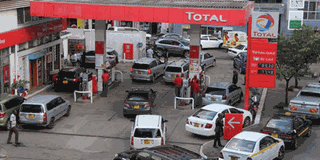Kenya’s future is urban; let us embrace it

Motorists queue to fuel at a petrol station in Nairobi CBD on May 12, 2015. Many Kenyans born in rural areas end up in urban centres after school. PHOTO | JEFF ANGOTE | NATION MEDIA GROUP
What you need to know:
- The vast majority of Kenyans were born in rural areas, but for the middle class and working class folks in formal jobs and business over 40 years of age, once they left secondary school, most of them ended up living virtually all their adult life in urban areas.
- Most of our political and social leaders find themselves perpetually extolling the virtues of rural life in contrast to urban life, the obligations owed to ancestral rural communities.
- The ground under the rural preference and bucolic collective national psyche is shifting towards a totally different demographic and settlements future.
One of the more surprising things, whenever I have discussions with my peers, is their ambiguity about their belonging to cities or, for that matter, any urban area.
Granted, the vast majority of Kenyans were born in rural areas, but for the middle class and working class folks in formal jobs and business over 40 years of age, once they left secondary school, most of them ended up living virtually all their adult life in urban areas.
May be it is because collectively as a country and society, we have bought the myth that rural is good and urban is bad, and deeply embedded it in our national psyche.
It is so deeply held that most of our political and social leaders, consciously and unconsciously, find themselves perpetually extolling the virtues of rural life in contrast to urban life, the obligations owed to ancestral rural communities, and why cutting off links with the rural to become wholly urban is cultural and social suicide.
Many of us true urbanites who were born and have lived all their lives in cities are forced to swear allegiance to ancestral rural communities and counties in order to fit in.
We even get buried when that time comes in some ancestral land one never even knew about or rarely visited because the funeral committee cannot bear to “throw us away” in Lang’ata or Kisauni cemeteries.
RURAL BORN PEERS
At election time, we join our rural born peers by registering and voting in so-called ancestral constituencies and wards. We elect governors, senators, MPs, and MCAs for places we don’t live in, and then come back to the cities to find that others have elected governors, senators, MPs and MCAs that we do not know for the places we live in 350 days out of 365 days in a year.
However, the ground under the rural preference and bucolic collective national psyche is shifting imperceptibly towards a totally different demographic and settlements future.
As one travels across the country, one cannot fail to notice how many people now live in peri-urban and urban settlements, most of which cluster along key arteries, road junctions, trucking stops, administrative and market centres.
It is quite likely a number of these settlements have populations of more than 10,000 inhabitants, and should rightly be considered as emerging towns.
There are also a number of towns whose populations are now over 250,000 people and should, therefore, be considered as municipalities, and others with more than 500,000 people that are cities in the making.
Despite this growing urbanisation, the rural bias remains strong even in political representation. For instance, Nairobi and Mombasa, whose combined population is more than 10 per cent of the national population, have 23 instead of their rightful share of 29 out of the 290 constituency seats in the National Assembly.
EMBRACING URBANITY
Political acceptance is needed to change our national psyche towards embracing urbanity in parliamentary representation. Given the 290 parliamentary seats will be redistributed every 10 years after the census, the successive censuses of 2019, 2029 and 2039, will see urban and peri-urban parliamentary representation grow from less than 10 per cent today to nearly 70 per cent of all elected seats by 2040, just 25 years from now.
Are we ready for redistributed political power from rural constituencies and polities to urban ones? Are we ready for the shift that will take place following the 2019 census that will probably double the number of urban seats to be contested in the 2022 elections? One hopes the electoral commission is preparing itself and the people of Kenya by identifying those constituencies that will urbanise over the next 25 years and prepare accordingly, so that no one is caught by surprise.
Given the rural bias, it is probably not surprising the Urban Areas and Cities Act of 2011 is yet to be operationalised so that all urban areas and cities are run by county governments currently, instead of city or municipality boards as envisaged in the law.
This has created uncertainty, for instance, in the status of places such as Mtwapa, Ngong-Kiserian, Ongata Rongai, and Athi River-Kitengela.
Let us accept that in the near future, in our lifetimes, the majority of Kenyans will be born, grow up, study, work, raise families, vote, and be buried not in ancestral rural counties but in the cities, municipalities and towns.




